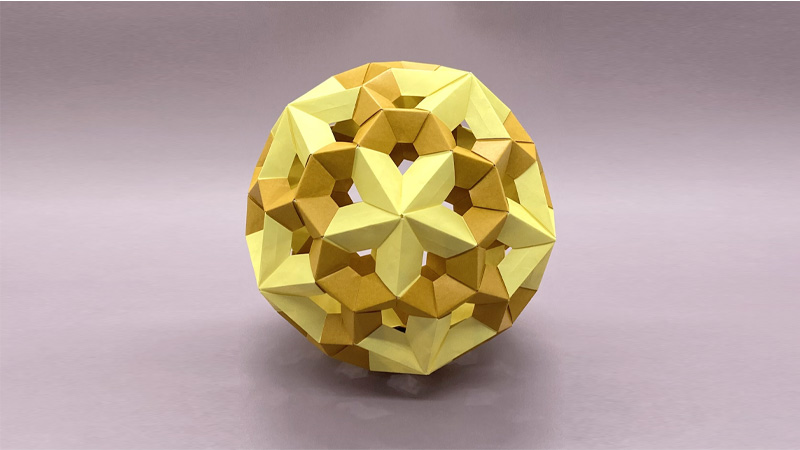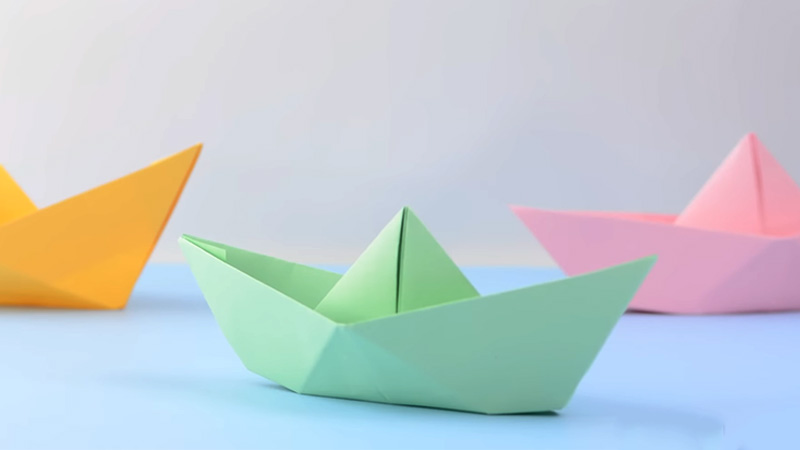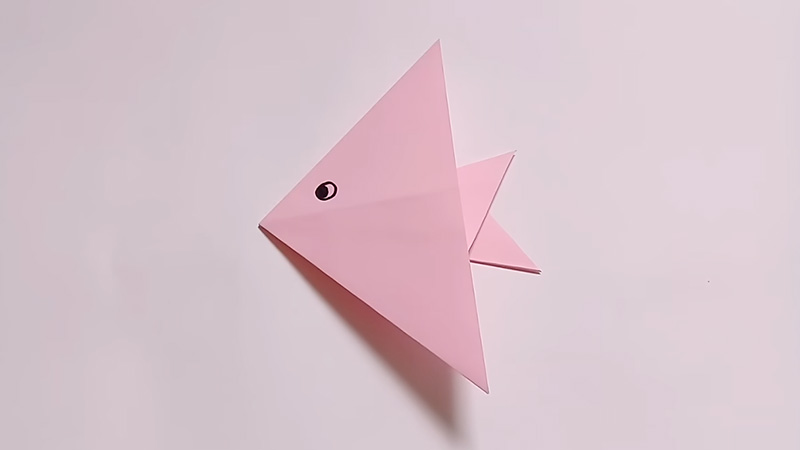Origami, the ancient art of paper folding, transcends its humble origins to emerge as a captivating visual art form.
With its roots deeply embedded in Japanese culture, origami has evolved into a medium that blends intricate craftsmanship with creative expression.
Through the meticulous manipulation of paper, artists craft mesmerizing sculptures and designs that captivate the eye.
Its emphasis on form, composition, and balance positions origami alongside traditional visual arts.
As origami practitioners meticulously fold and shape paper, they embark on a journey of artistic creation, employing various paper types, colors, and textures to convey emotion, narrative, and abstract concepts. In this exploration, we delve into the question: Is origami a visual art?

Is Origami a Visual Art?
Yes, Origami, the traditional Japanese art of paper folding, is undeniably a visual art form.
While it may not be as widely recognized as painting, sculpture, or other more conventional visual arts, origami’s beauty lies in its intricate and delicate creations, which are meticulously crafted from a single sheet of paper.
Here are the reasons why origami is called the visual art:
Aesthetic Complexity
Origami designs can range from simple, elegant forms to highly intricate and complex sculptures. Artists fold paper into various shapes, creating visually captivating patterns, textures, and symmetries.
The transformation of a flat sheet of paper into a three-dimensional masterpiece is an art form in itself.
Use of Color and Pattern
Origami artists often use colored or patterned paper to enhance the visual impact of their creations. The choice of paper can convey emotions and themes, adding depth and dimension to the artwork.
Precision and Attention to Detail
Achieving the desired result in origami requires a high level of precision and attention to detail.
Artists must meticulously follow folding instructions and execute each step with care to create a visually pleasing final product.
Sculptural Quality
Many origami creations take on a sculptural quality, resembling animals, plants, or abstract forms.
These sculptures can be displayed as standalone pieces of art, and their visual impact is heightened by the precision and craftsmanship involved.
Unique Expressions
Origami artists often infuse their work with personal expressions, creativity, and innovation. This individuality adds uniqueness to each piece, making origami a personal form of visual expression.
Cultural Significance
Origami carries cultural and historical significance in Japan and around the world. It is a reflection of Japanese aesthetics and is used in various ceremonial and artistic contexts, further solidifying its status as a visual art.
Contemporary Origami Art
In recent years, contemporary origami artists have pushed the boundaries of the art form by creating large-scale installations, abstract compositions, and experimental designs.
These works challenge traditional notions of paper folding and expand the possibilities of origami as a visual art form.
What Period Did Origami Become Viewed as an Art Form?

Origami has a long history that dates back to ancient times in Japan, but it started to be viewed as an art form during the Edo period (1603-1868).
During this period, origami underwent significant developments in terms of techniques, styles, and cultural significance.
One key factor in origami’s transition to an art form was its association with the Japanese aristocracy and nobility.
It was used in ceremonial and ritualistic contexts, such as in the folding of ceremonial paper cranes. Origami patterns became more complex and symbolic during this time.
Additionally, origami was featured in written works like “Senbazuru Orikata” (The Folding of a Thousand Cranes) by Akisato Rito, published in 1797, which helped establish folding patterns and rules for creating intricate designs.
As Japan opened up to the Western world in the late 19th century, origami began to spread internationally, further solidifying its status as an art form.
In the 20th century, artists like Akira Yoshizawa contributed significantly to origami’s recognition as an art form through their innovative creations and teachings.
So, while origami has ancient origins, it gained recognition as an art form primarily during the Edo period and continued to evolve and flourish in subsequent centuries.
Uses of Origami as a Visual Art

Origami, as a visual art form, has a wide range of uses and applications, both traditional and contemporary.
Here are some of the key uses of origami as a visual art:
Decorative Art
Origami creations can be used for decoration in homes, offices, and public spaces. Intricately folded origami sculptures, ornaments, and mobiles can add a unique and visually appealing touch to interior design.
Art Exhibitions
Origami artists frequently participate in art exhibitions, showcasing their creations alongside other visual artworks.
These exhibitions provide a platform for artists to share their work with the public and art enthusiasts.
Educational Tools
Origami is used in educational settings to teach geometry, mathematics, and spatial reasoning. It can make abstract concepts more tangible and engaging for students.
Therapeutic Art
Origami is sometimes used as a therapeutic tool for relaxation and stress relief. The meditative and focused nature of folding can have a calming effect, making it a form of art therapy.
Fashion and Wearable Art
Origami techniques are employed in fashion design, creating unique clothing, accessories, and jewelry pieces. Origami-inspired fashion items often feature geometric and structured designs.
Product Packaging
Origami-inspired packaging is used in various industries, from luxury goods to consumer products. The folding techniques are employed to create aesthetically pleasing and functional packaging solutions.
Installation Art
Large-scale origami installations are created for art exhibitions and public spaces. These installations often involve hundreds or thousands of folded units to form visually stunning and immersive environments.
Origami Photography
Origami can be the subject of photography, with artists and photographers capturing the intricate details and patterns of folded paper creations.
Storytelling and Narrative Art
Origami can be used to illustrate stories and narratives, with folded figures and scenes acting as visual aids in storytelling or as part of book illustrations.
Environmental Art
Some artists use recycled materials to create origami sculptures, emphasizing sustainability and environmental awareness through their art.
Social and Cultural Art
Origami is often integrated into cultural celebrations and festivals, such as the folding of paper cranes for good luck or the creation of origami animals during Chinese New Year.
Scientific Visualization
Origami techniques have applications in science and engineering, where they are used to model complex structures and concepts.
For example, they have been used to design foldable and deployable structures for space exploration.
FAQS
What is origami art?
Origami art is the practice of creating intricate sculptures and designs by folding paper.
Is origami considered art?
Yes, origami is considered a form of art. It combines creativity, craftsmanship, and aesthetics to produce visually engaging and emotionally resonant works.
Is origami a sculpture?
Origami can be considered a form of sculpture. Artists transform flat sheets of paper into three-dimensional objects, which are indeed sculptures created through folding.
What kind of art is origami?
Origami is primarily categorized as a visual art, but it can also encompass elements of sculpture and craft due to its focus on form and creative expression through paper folding.
To Recap
The question of whether origami is a visual art finds its answer in the intricate beauty and creative depth that paper folding offers.
From the delicate precision of each fold to the imaginative compositions that emerge, origami stands as a testament to the fusion of craftsmanship and artistic expression.
Its cultural significance, inclusion in art exhibitions, and its vibrant community of artists further affirm its status as a visual art form.
Through the manipulation of paper, origami artists transcend the ordinary and engage the senses, evoking emotions and narratives in their creations.
As we explore its intricate world, it becomes evident that origami is not just an art form; it is a captivating visual art that continues to inspire and enchant.
Leave a Reply